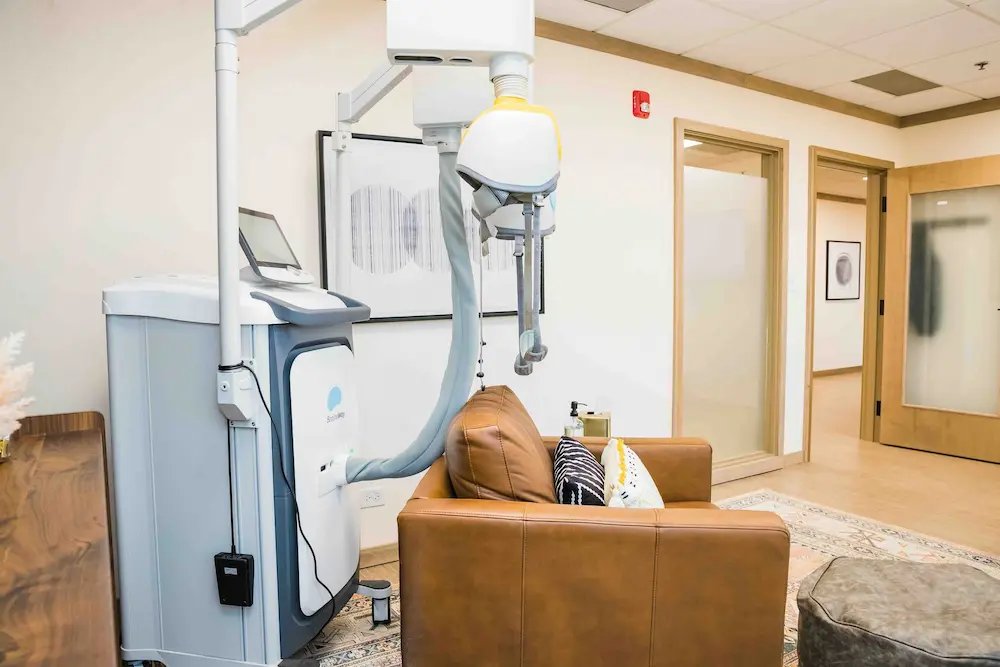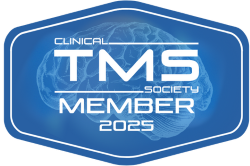
For many people living with depression and other mental health conditions, finding the right treatment can feel like a long, exhausting journey. While antidepressant medication is often the first step, studies show that up to one-third of people with major depression do not respond to antidepressants at all, and many others only achieve partial relief.
That’s why researchers have continued to explore other treatment options. In fact, research from Harvard shows that approximately 50% to 60% of people with depression who have not improved with medication experience a meaningful response with transcranial magnetic stimulation (TMS). Even more encouraging, about one-third achieve full remission, meaning their depression symptoms go away completely.
Clearly, TMS works for many people. But if you’re new to it, you may wonder: is TMS safe?
That’s an important question, and the answer is reassuring. TMS is FDA-approved, has been studied in clinical trials for decades, and has a strong safety record to back it up.
What Is Transcranial Magnetic Stimulation (TMS)?
Transcranial magnetic stimulation is a non-invasive brain stimulation technique that uses targeted magnetic pulses to activate nerve cells in specific brain regions. Unlike antidepressant medication, which affects the entire body, TMS works directly on the circuits involved in mood regulation.
The Food and Drug Administration (FDA) first approved TMS in 2008 for adults with major depression who had not responded to standard treatment. Since then, research has expanded its use for conditions including:
- Obsessive-compulsive disorder (OCD)
- Post-traumatic stress disorder (PTSD)
- Anxiety disorders
- Attention-deficit/hyperactivity disorder (ADHD)
- Smoking cessation
- Traumatic brain injury
It’s also being studied for its efficacy in treating neurological conditions like Parkinson’s disease and Alzheimer’s.
Because TMS does not require surgery or anesthesia, it is very different from treatments like deep brain stimulation or electroconvulsive therapy. TMS is performed in an outpatient medical center setting, and patients remain awake and alert.

How Does TMS Work?
To understand how TMS helps relieve depression symptoms, one needs to examine the brain’s electrical activity.
The TMS device contains a magnetic coil, usually placed over the scalp near the motor cortex or prefrontal cortex. When the coil delivers magnetic pulses, these pass painlessly through the skull and stimulate brain cells. The stimulation improves communication between brain regions that are often underactive in people with major depression.
This gentle modulation of brain circuits promotes better mood regulation, concentration, and motivation. And because the stimulation is localized, there are no systemic side effects like weight gain, fatigue, or sexual dysfunction, effects that are sometimes seen with antidepressant medication.
Is TMS Safe? Evidence From Clinical Trials
When asking “Is TMS safe?”, the best place to look is clinical data. TMS has been studied extensively over the past three decades, and the results are clear: it is considered a safe treatment with a very low risk of serious complications.
- FDA approval: The Food and Drug Administration approved TMS for treatment-resistant depression after reviewing large clinical trials that demonstrated its effectiveness and safety.
- Risk of seizures: The most serious potential side effect is a seizure, but the risk is extremely low, estimated at less than 0.1% of patients. This risk is lower than with many antidepressant medications.
- Long-term TMS safety: Studies following patients for years show no negative effects on memory, cognition, or overall brain health.
- Clinical trials: A recent review of numerous clinical trials concluded that TMS is “well-tolerated and safe” when administered by trained health care providers.
It’s also worth noting that millions of TMS treatment sessions have now been safely administered worldwide.
Common Side Effects of TMS
Compared to antidepressant medication, TMS has a very different side effect profile. The reason is simple: because it acts only on the targeted brain regions, it does not circulate through the bloodstream and therefore causes no systemic side effects.
That said, some people may experience generally mild, temporary effects, especially in the first week or two of treatment:
- Mild scalp discomfort at the treatment site
- Headache during or shortly after treatment
- Tingling or tapping sensation while the magnetic pulses are delivered
These effects usually improve after the first few sessions, as the body adjusts to the stimulation.
Unlike medication, TMS does not cause drowsiness, digestive upset, weight changes, or sexual side effects. Most patients can continue their daily activities, including work and driving, immediately after their sessions.
What Does a TMS Treatment Session Feel Like?
If you’ve never experienced TMS, you may wonder what happens during a session.
Here’s what you can expect:
- Preparation: You’ll sit in a comfortable chair. A trained technician or clinician positions the magnetic coil against your head.
- Mapping: During the first session, your provider will determine the right spot on your motor cortex to deliver the pulses, ensuring precision.
- Stimulation: As the machine begins, you’ll feel a series of gentle taps or pulses. These are not painful, though they can feel unusual at first.
- Duration: Sessions usually last 20 to 40 minutes. You remain awake, and no anesthesia is required.
- Aftercare: No recovery time is needed. Most people drive themselves home or return to work right after.
A full course of treatment typically involves five sessions per week over four to six weeks. Some patients may receive additional weeks of treatment or sessions (called “maintenance TMS”) to help sustain results.

Who Is a Good Candidate for TMS?
TMS is not for everyone, but many people who have struggled with depression or other conditions may benefit.
Ideal candidates include:
- Adults with major depression who have not responded to at least one course of antidepressant medication.
- Individuals with treatment-resistant depression, meaning they’ve tried multiple medications without success.
- People living with OCD, PTSD, anxiety, or ADHD, where research is increasingly supporting TMS as a useful option.
- Those seeking alternatives to medications due to side effects or lack of benefit.
- Individuals interested in new approaches for smoking cessation or recovery after traumatic brain injury.
Who may not be a candidate:
- People with implanted metallic devices near the head (such as cochlear implants or deep-brain stimulators).
- Those with uncontrolled seizures.
- Individuals with certain unstable medical conditions.
The best way to determine candidacy is through a consultation at a specialized medical center.
TMS vs. Other Treatments
Understanding how TMS fits into the broader landscape of depression treatment can help put its safety in context.
- Antidepressant medication: Works systemically, which means side effects are more common. TMS is localized, with no systemic side effects.
- Electroconvulsive therapy (ECT): Highly effective but requires anesthesia and can cause memory side effects. TMS does not involve anesthesia and has no cognitive risks.
- Deep brain stimulation: Requires surgical implantation of electrodes. TMS is non-invasive and is done entirely from outside the skull.
This comparison shows why many patients turn to TMS after struggling with medication or seeking a less invasive alternative to other brain stimulation techniques.
Is TMS Safe?
So, is TMS safe? The evidence says yes.
- It is FDA-approved for depression and backed by decades of clinical trials.
- The most significant risk, seizures, is extremely rare.
- Side effects are generally mild and temporary, with no systemic side effects.
- TMS has helped countless people find relief from major depression, OCD, PTSD, anxiety, ADHD, and more, especially when other treatments haven’t worked.
If you’ve been living with depression symptoms or struggling to find a treatment that works, TMS may be worth considering.
Relief Mental Health’s Approach
At Relief Mental Health, TMS is delivered with care, precision, and attention to your overall well-being. Every treatment session is overseen by trained professionals who prioritize your safety and support.
If you’re curious whether TMS might be right for you, Relief Mental Health can guide you through the process and answer your questions. Taking the next step could mean finding the relief you’ve been searching for.


